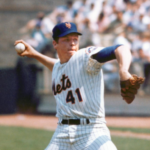On this date in 1934, the Brooklyn Dodgers signed Casey Stengel to a two-year deal to be their manager.
Today, 77 years later, Terry Collins will look to the example set by Stengel in running a baseball team. Though they Mets were downright terrible during Stengel’s tenure, the fire and energy he brought as the first Mets manager rang true with the players.
Early reports have described Collins as “loud,” which is a great sign for the Mets. The last three managers, Art Howe, Willie Randolph and Jerry Manuel, were more soft spoken in trying to get their points across. Half the time, did we even know what Manuel was saying?
The Mets have some players in need of a jolt, and Collins will be the one to provide that jolt. If the player doesn’t respond, Collins will look for someone who will.
I just started reading Michael Lewis’ Moneyball, and it has been a terrific read thus far.
For those unfamiliar, Lewis chronicles the Oakland A’s front office tactics in using as little money as possible to field a winning team.
The strategy worked out very well in the early 2000s. Before current A’s general manager, Billy Beane, took over, Sandy Alderson was calling the shots.
Alderson came in as a graduate from Dartmouth College and Harvard Law School. He began the wave of “nerds” that didn’t know much about baseball but could use their knowledge to build a winning team.
Alderson placed the highest value in on-base percentage. Some baseball people look only at BA, HR and RBI, but Alderson believed that OBP was the key to scoring runs.
And he was right. You can’t score runs if you don’t have guys on base, unless of course you hit a ton of solo home runs, which is unlikely to win ballgames.
Alderson was notorious for finding a manager who would subscribe to his theory. He once threatened the A’s Double-A manager that he would be fired if his team didn’t start drawing more walks, thus improving their OBP.
Tony LaRussa was Oakland’s manager when Alderson took over, so you could only imagine the clash that occurred. LaRussa refused to buy into the new style of baseball, forcing Alderson to look elsewhere.
Sure enough, Art Howe was named the A’s manager, serving as Alderson’s puppet.
“Art Howe was hired to implement the ideas of the front office, not his own,” said Alderson.
That leads me back to Terry Collins. Obviously, Alderson believes Collins will support the theory or else he wouldn’t have been hired.
The Mets are in a similar situation as the A’s were: a team with a high payroll that wasn’t getting value out of their players. Before Alderson took over, the A’s had one of the highest payrolls in league with players like Mark McGwire, Jose Canseco and Rickey Henderson leading the way.
In the mid-1990s, the A’s new owners forced Alderson to cut the payroll, which is uncannily similar to the Wilpons’ situation. Maybe no money schemes were involved, but Alderson still had to do a lot with a little.
So the new goal for the Mets will be for Alderson to bring in players with value and have Collins utilize those players to reach their full potential. Only time will tell if this plan works.
After reading some of the book, I’m starting to buy into this theory as well. As the famous proverb states, “If it happened before then it can happen again.”
Follow me on Twitter @JMMancari.













